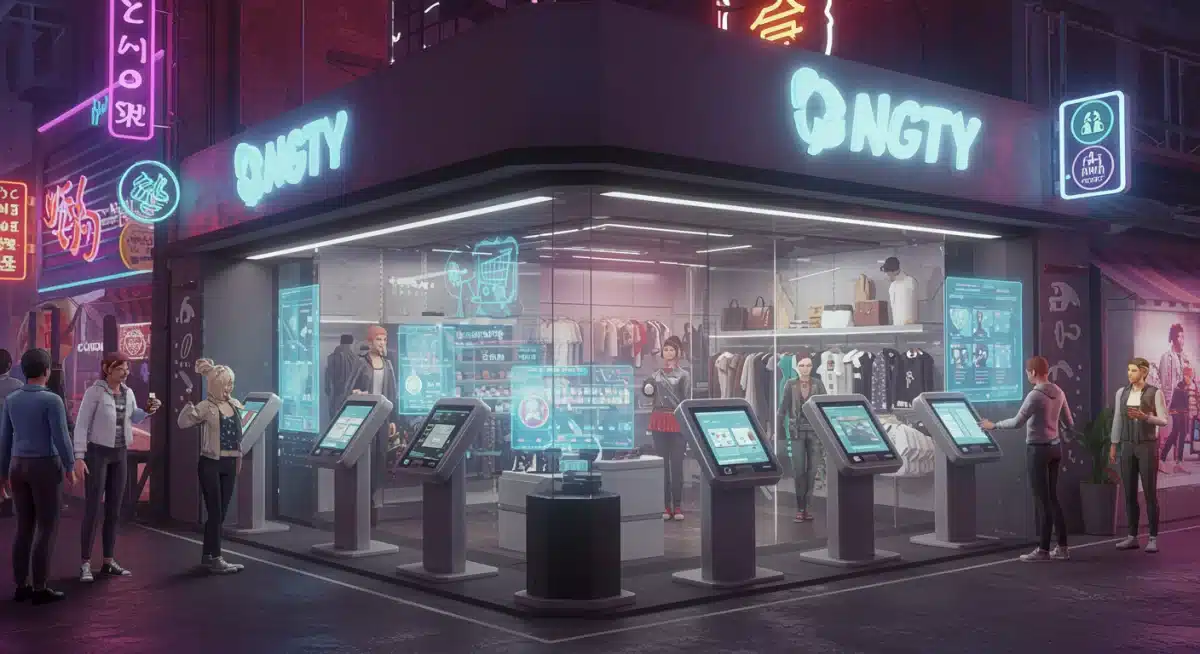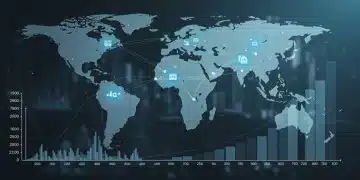Decoding the Metaverse: Business Opportunities Explored

Decoding the Metaverse: Opportunities for Businesses in the Emerging Digital World offers a comprehensive look at the evolving digital frontier, highlighting key strategies and potential challenges for enterprises in the United States, as reported by industry experts and market analysts.
The concept of the metaverse, once a subject of science fiction, is rapidly becoming a tangible reality, presenting an intricate web of opportunities and challenges for businesses across all sectors. Decoding the Metaverse: Opportunities for Businesses in the Emerging Digital World is no longer a futuristic speculation but an immediate strategic imperative. As digital ecosystems evolve, understanding this nascent landscape is crucial for companies aiming to maintain relevance and foster innovation in a competitive global market.
Understanding the Metaverse Landscape
The metaverse, in its current iteration, is not a single, unified platform but a collection of interconnected virtual worlds, augmented reality (AR) experiences, and digital ecosystems. It represents the next evolutionary stage of the internet, promising persistent, shared, 3D virtual spaces where users can interact, socialize, work, and transact. For businesses, this means a paradigm shift in how they engage with customers, develop products, and even structure their operations. Early adopters are already experimenting with virtual storefronts, digital events, and immersive advertising campaigns.
The foundational technologies enabling the metaverse include virtual reality (VR), augmented reality (AR), blockchain, artificial intelligence (AI), and 5G connectivity. These technologies converge to create rich, interactive environments that blur the lines between the physical and digital. The growth of these underlying technologies is accelerating, making the metaverse a rapidly expanding frontier. Companies that grasp these fundamentals will be better positioned to capitalize on the emerging trends and define their presence in this new digital realm.
Key Components of the Metaverse
- Virtual Worlds: Decentraland, The Sandbox, Roblox, and VRChat offer persistent digital environments where users can own land, build experiences, and interact.
- Augmented Reality: Applications that overlay digital information onto the real world, enhancing physical experiences and offering new avenues for product visualization and interaction.
- Non-Fungible Tokens (NFTs): Digital assets that represent ownership of unique items within the metaverse, enabling digital scarcity and a new economy for virtual goods.
- Decentralized Autonomous Organizations (DAOs): Community-led organizations that govern certain metaverse platforms, allowing for collective decision-making and ownership.
The convergence of these components creates a rich, interconnected digital fabric where businesses can innovate. From creating unique brand experiences to facilitating secure digital transactions, the possibilities are vast. Understanding each component’s role is critical for any business looking to integrate effectively into the metaverse ecosystem.
New Avenues for Customer Engagement and Branding
One of the most compelling aspects of the metaverse for businesses is its potential to revolutionize customer engagement. Traditional marketing and sales channels are evolving, and the metaverse offers immersive, interactive experiences that can build deeper connections with consumers. Brands are no longer limited to 2D advertisements; they can create virtual showrooms, host digital fashion shows, or offer interactive product demonstrations that transcend geographical boundaries.
The ability to create persistent digital identities and communities within the metaverse allows for sustained brand interaction. Consumers can experience a brand’s ethos in a fully immersive environment, leading to stronger brand loyalty and a more profound understanding of product offerings. This shift demands a creative approach to branding, focusing on experiential marketing and community building rather than just transactional interactions. Businesses must think about how their brand translates into a 3D, interactive space.
Innovative Marketing Strategies
- Virtual Storefronts: Create immersive retail spaces where customers can browse, try on (via avatars), and purchase digital or physical goods.
- Experiential Marketing: Host virtual concerts, art exhibitions, or interactive games that align with brand values and engage users in unique ways.
- Digital Collectibles: Offer NFTs as exclusive merchandise, loyalty rewards, or access passes to special events, fostering a sense of ownership and community.
- Metaverse Advertising: Integrate dynamic advertisements within virtual worlds, leveraging contextual placement and interactive formats to reach target audiences.
These strategies offer a glimpse into the future of marketing, where engagement is not just about reach but about depth of experience. Brands that successfully navigate this new terrain will be those that prioritize authenticity, creativity, and genuine interaction within their metaverse presence. The challenge lies in crafting experiences that resonate with a digitally native audience while staying true to core brand identity.
The Rise of Metaverse Commerce and Digital Economies
The metaverse is poised to redefine commerce, introducing new forms of digital economies driven by cryptocurrencies, NFTs, and virtual goods. This emerging ecosystem enables businesses to create, sell, and manage digital assets in ways previously unimaginable. From virtual real estate to avatar wearables, a burgeoning market for digital commodities is rapidly expanding, offering significant revenue opportunities for businesses willing to innovate.
Blockchain technology underpins much of this digital economy, providing secure, transparent, and verifiable ownership of digital assets. This ensures trust and facilitates transactions within the metaverse, making it a fertile ground for new business models. Companies can leverage NFTs to create unique product lines, offer exclusive digital experiences, or even fractionalize ownership of high-value assets. The transition to metaverse commerce requires a deep understanding of these underlying technologies and the evolving consumer behavior within digital worlds.

The shift towards a digital-first economy means businesses must consider how their products and services can be digitized or complemented by digital offerings. This includes not only direct sales within the metaverse but also creating interoperable assets that can be used across different virtual platforms. The potential for new revenue streams is immense, but it demands strategic planning and an adaptive approach to business development.
Monetization Models in the Metaverse
- Virtual Goods and Services: Selling digital clothing, accessories, virtual land, or unique in-game experiences.
- NFT Marketplaces: Creating platforms for users to buy, sell, and trade unique digital assets, often taking a commission on transactions.
- Advertising and Sponsorships: Brands can sponsor virtual events, place digital billboards, or create branded experiences within popular metaverse platforms.
- Subscription Models: Offering premium access to exclusive content, features, or communities within the metaverse.
These models illustrate the diverse ways businesses can generate revenue in the metaverse. Success will depend on identifying target audiences, understanding their needs within digital environments, and creating compelling value propositions. The integration of blockchain and decentralized finance (DeFi) tools will further enhance the sophistication and security of these digital economies, presenting both opportunities and regulatory complexities.
Challenges and Risks for Businesses in the Metaverse
While the metaverse presents exciting opportunities, it also comes with a unique set of challenges and risks that businesses must navigate. Technical hurdles, such as interoperability between different virtual platforms and the need for robust infrastructure, are still significant. Furthermore, the nascent regulatory landscape surrounding digital assets, data privacy, and intellectual property in the metaverse poses considerable legal and ethical questions.
Security concerns, including cyberattacks, fraud, and identity theft, are amplified in a persistent, interconnected digital environment. Businesses must invest in advanced cybersecurity measures and educate their users on best practices. Social and ethical considerations, such as digital harassment, addiction, and the potential for a deeper digital divide, also require careful attention. Companies must develop responsible metaverse strategies that prioritize user safety and well-being.
Navigating Key Challenges
- Interoperability: Ensuring seamless transitions and asset transfer between different metaverse platforms remains a technical and industry-wide challenge.
- Regulatory Uncertainty: The lack of clear legal frameworks for digital assets, virtual economies, and user data can create compliance risks.
- Cybersecurity: Protecting digital assets, user identities, and transactions from sophisticated cyber threats is paramount.
- User Experience: Designing intuitive, engaging, and accessible metaverse experiences for a diverse user base requires significant investment in design and development.
Addressing these challenges requires a collaborative approach, involving technology developers, legal experts, policymakers, and user communities. Businesses that prioritize robust security, ethical design, and active participation in shaping regulatory frameworks will be better equipped to mitigate risks and build sustainable metaverse presences. The journey into the metaverse is not without its obstacles, but proactive engagement can turn these challenges into opportunities for leadership and innovation.
Building a Metaverse Strategy: Key Steps
For businesses looking to enter or expand their presence in the metaverse, a well-defined strategy is essential. This involves understanding the current state of the technology, identifying relevant platforms, and aligning metaverse initiatives with broader business objectives. The first step is often exploration and experimentation, starting with smaller projects to gain insights and learn from user feedback.
Developing a metaverse strategy also requires investing in the right talent and technology. This might include hiring specialists in 3D design, blockchain development, or virtual experience creation. Collaboration with metaverse platforms and technology providers can accelerate entry and reduce initial investment risks. Furthermore, a flexible and iterative approach is crucial, as the metaverse is a rapidly evolving space where new trends and technologies emerge constantly.
Essential Strategic Considerations
- Define Objectives: Clearly articulate what the business aims to achieve in the metaverse (e.g., brand awareness, new revenue streams, enhanced customer service).
- Identify Target Audience: Understand who the metaverse users are and which platforms they frequent to tailor experiences effectively.
- Choose Platforms Wisely: Select metaverse platforms that align with business goals and target demographics, considering their ecosystem, user base, and technical capabilities.
- Start Small, Scale Smart: Begin with pilot projects to test concepts, gather data, and refine strategies before committing to large-scale investments.

A successful metaverse strategy is not a static plan but a dynamic roadmap that adapts to technological advancements and user preferences. Businesses must be willing to iterate, learn from failures, and continuously optimize their presence to maximize the opportunities presented by this new digital frontier. Early movers who adopt a strategic and agile approach are likely to gain a significant competitive advantage in the long run.
The Future Outlook: Metaverse Evolution and Impact
The metaverse is still in its nascent stages, but its trajectory suggests a profound impact on various industries and aspects of daily life. Experts predict continued advancements in VR/AR hardware, making immersive experiences more accessible and realistic. The development of open standards and protocols will likely foster greater interoperability, creating a more unified and seamless metaverse experience. This evolution will further unlock opportunities for businesses, from hyper-personalized advertising to entirely new forms of digital entertainment and education.
The economic impact of the metaverse is projected to be substantial, with some forecasts estimating it could contribute trillions to the global economy within the next decade. This growth will be driven by increased consumer spending on digital goods, virtual events, and immersive experiences, as well as new business models emerging from the intersection of AI, blockchain, and virtual reality. Businesses that position themselves strategically now will be at the forefront of this economic transformation, shaping the future of digital interaction and commerce.
As the metaverse matures, we can expect to see a greater integration of physical and digital realities, leading to hybrid experiences that redefine work, leisure, and social interaction. This convergence will necessitate innovative approaches to everything from urban planning in virtual cities to the development of ethical AI companions. The potential for Decoding the Metaverse: Opportunities for Businesses in the Emerging Digital World is immense, promising not just new markets but entirely new ways of living and operating.
| Key Aspect | Business Opportunity |
|---|---|
| Customer Engagement | Immersive brand experiences, virtual events, and interactive product showcases. |
| Digital Economy | NFTs, virtual goods sales, digital currency transactions, and new monetization models. |
| Work & Collaboration | Virtual offices, remote collaboration tools, and immersive training simulations. |
| Innovation & R&D | Prototyping, virtual product testing, and new service development in digital environments. |
Frequently Asked Questions About Metaverse Business Opportunities
The metaverse is a persistent, interconnected network of 3D virtual worlds where businesses can create immersive experiences, engage customers, sell digital goods, and conduct operations. It’s an evolution of the internet towards more interactive and spatial digital environments.
Small businesses can leverage the metaverse for innovative marketing, virtual storefronts, digital product sales (NFTs), and global customer reach without physical barriers. It offers a new, cost-effective channel for brand building and community engagement.
Key risks include regulatory uncertainty, high development costs, cybersecurity threats, intellectual property issues, and the challenge of achieving interoperability across platforms. Businesses must also address potential user privacy and ethical concerns.
Industries like retail, entertainment, gaming, education, real estate, and manufacturing are poised for significant transformation. The metaverse offers new avenues for product development, service delivery, and customer interaction across these sectors.
While still evolving, early adoption allows businesses to experiment, learn, and establish a foundational presence. Strategic entry now can provide a competitive advantage, shaping future engagement models and unlocking novel revenue opportunities in the emerging digital economy.
What this means
The ongoing development of the metaverse marks a profound shift in how businesses will operate, compete, and create value in the coming years. As immersive environments become more sophisticated and user expectations evolve, companies will need to move beyond experimentation and begin designing long-term digital strategies that align with these new interaction models. This includes rethinking product delivery, customer engagement, and even workforce collaboration within virtual ecosystems.
Market leaders will be those who not only understand the technological layer but also anticipate regulatory frameworks, digital asset governance, and new forms of consumer identity and ownership. Emerging insights from specialized metaverse publications like https://www.koganpage.com/digital-technology/decoding-the-metaverse-9781398609044 highlight how digital ownership, tokenized economies, and immersive brand experiences are likely to redefine competitive positioning for forward-thinking organizations.
Ultimately, the metaverse is not just an extension of the internet but a restructuring of digital presence itself. Businesses that prepare now—by investing in virtual infrastructure, building adaptable digital policies, and fostering internal innovation capabilities—will be best positioned to lead in this hybrid future where physical and virtual commerce coexist as standard practice.





